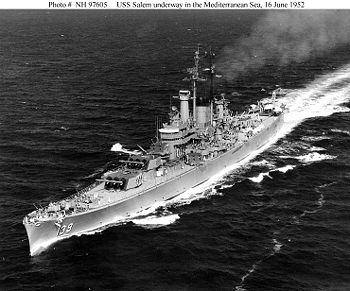Des Moines-class: Difference between revisions
Pat Palmer (talk | contribs) m (Text replacement - "U.S. Navy" to "United States Navy") |
John Leach (talk | contribs) m (Text replacement - "{{subpages}}" to "{{PropDel}}<br><br>{{subpages}}") |
||
| Line 1: | Line 1: | ||
{{subpages}} | {{PropDel}}<br><br>{{subpages}} | ||
Three heavy cruisers formed the '''Des Moines-class''' of the [[United States Navy]]: [[USS Des Moines (CA-134)|''USS Des Moines'' (CA-134)]], [[USS Salem (CA-139)|''USS Salem'' (CA-139)]], and [[USS Newport News (CA-148)|''USS Newport News'' (CA-148)]]. They were larger (17,000 tons) than the Baltimores. The first heavy cruisers commissioned after the [[Second World War]], they were modified from the [[Boston-class]]. All, at one time or another, were flagship of the [[United States Sixth Fleet]], although admirals probably preferred to be on the ''Newport News'' and ''Salem'', which were air conditioned. The namesake of the class, ''Des Moines'' (CA 134), was not. | Three heavy cruisers formed the '''Des Moines-class''' of the [[United States Navy]]: [[USS Des Moines (CA-134)|''USS Des Moines'' (CA-134)]], [[USS Salem (CA-139)|''USS Salem'' (CA-139)]], and [[USS Newport News (CA-148)|''USS Newport News'' (CA-148)]]. They were larger (17,000 tons) than the Baltimores. The first heavy cruisers commissioned after the [[Second World War]], they were modified from the [[Boston-class]]. All, at one time or another, were flagship of the [[United States Sixth Fleet]], although admirals probably preferred to be on the ''Newport News'' and ''Salem'', which were air conditioned. The namesake of the class, ''Des Moines'' (CA 134), was not. | ||
Revision as of 14:42, 8 April 2024
| This article may be deleted soon. | ||
|---|---|---|
Three heavy cruisers formed the Des Moines-class of the United States Navy: USS Des Moines (CA-134), USS Salem (CA-139), and USS Newport News (CA-148). They were larger (17,000 tons) than the Baltimores. The first heavy cruisers commissioned after the Second World War, they were modified from the Boston-class. All, at one time or another, were flagship of the United States Sixth Fleet, although admirals probably preferred to be on the Newport News and Salem, which were air conditioned. The namesake of the class, Des Moines (CA 134), was not. Discussions of postwar cruisers tend to focus on the conversions to guided missile cruisers and new-construction guided missile cruisers, and ignore the last of these gun cruisers. The Soviet Union did build a larger number of postwar Sverdlovsk-class light cruisers. Since this class had a far higher rate of fire than earlier heavy cruisers, they provided exceptional naval gunfire support to ground troops. Still, the role of the heavy cruiser, in an era when the roar of surface gunfire actions disappeared into the echoes of history after the Battle of Surigao Strait, when aircraft had taken over the scouting role, and when guided missiles were clearly important but little understood, was unclear. This class had a new, and highly regarded, type of semi-automatic 8-inch/203mm gun. Only Newport News (CA 148), commissioned in January 1949, used her big guns extensively, in the Vietnam War. [1] USS Newport News was one of the few ships, along with destroyers, to be in an extended exchange with North Vietnamese shore batteries.[2] Its rate of fire meant that in some scenarios, it could deliver more explosive to an area than the 16"-50 caliber Mark 7 guns of battleships of the Iowa-class, and its better circular error probability let gunfire support be used much closer to friendly troops. Only the Salem is still in existence, as a museum ship, moored in Quincy, Massachusetts. [3] References
|
||
